NOTE *This article was orginally published January 2015 for Foundations Revealed. The link can be found here*
1887 B Baldwin Patent: Corset and method of making the same
This is the first part of a two-part series discussing B Baldwin’s 1887 patent 358249. This article will discuss the patent, it’s pattern and how it was created whereas the second will focus on recreating the corset and my methods used in its construction.
When I first saw this patent I was immediately attracted to the unusual paneling and the wonderful shapes the lines created. Personally I love corsets which have a focus on the waist section, such as some of the ventilated styles as opposed to your typical Victorian style with their up and down straight panels. I thought I could have some fun playing with color when recreating the pattern for the final corset.
As I’ve not before incorporated gores/gussets within a corset pattern before I knew this would also be a personal challenge. As someone with a petite frame and from a pattern cutters point of view I’ve associated gores and gussets with adding capacity and support for the more curvier figure. From a construction angle I must admit so far I’ve always avoided them as I knew it would be challenging to insert, particularly sewing round the corner at the apex of the gore. This patent would definitely be a learning curve both pattern wise and testing my sewing ability.
The Patent
The patent is comprised of two main parts, the first illustrates the corset and it’s parts- drawings of the pieces and the second is the specification that forms the letters of the patent declaring the description of the invention. The patent can be found here.
Baldwin’ patent relates invention of new improvements in corsets. As stated in the letters, Baldwin’s patent relates to the manufacture of corsets and its general object to Simplify and improve their construction. This could be accomplished by ‘so shaping the pieces of which each half of the corset is composed’
Part A shows two figures as seen below:

FIGURE 1 shows a completed half corset with all the stitching detail demonstrating the contruction in line with the written description
 FIGURE 2 is a general view showing an outline of the pieces of which the half corset is composed.
FIGURE 2 is a general view showing an outline of the pieces of which the half corset is composed.
Patent Observations
- The pattern was made up of 16 pieces (8 per half) it featured both hip and bust gores.
- Straight front busk used. No indication of depth of centre front given so length would be determined later on.
- The main body of the corset was made up of 4 pieces. I’ll rename the pieces as follows for the remainder of the article which will make it easier to distinguish than the numbers of the pieces in the patent (which in my opinion) were oddly marked Centre front (1), – – Front (3), Back (7), Centre back (2).
- The gores would also be referred to as Front bust gore (5) back bust gore (6) front hip gore (10) back hip gore (9).
Centre Front- The centre front was a straight strip piece to which the front was joined. The front seam of the FRONT Panel was curved which would give some curve to the corset over the abdomen region.
Front- As indicated on the drawing Point 4 denotes a slit cut into the pattern which would be opened out to insert the FRONT BUST GORE. The BACK BUST gore would also be partially joined.
Back- Would feature a cut away section which would be opened out slightly when inserting the BACK HIP GORE. This piece would also join to the FRONT HIP GORE creating that S bend curve.
Centre Back The centre back was a curved piece which would help curve the corset inward following the curvature of the spine. I did initially wonder at this point how the seam would be boned.
Object of the Patent
Relates to the manufacture of corsets, and has for its general object to simplify and improve their construction’ this would be achieved by the patent pattern lessening the number of seams in the garment.The essential principle being that the front and back body-sections are joined by a single curved and recurved seam, which follows naturally the curves of the body from between the shoulder blades at the back of the corset down across the waist and around the front of the hip to the bottom of the corset at the front. In doing so the corset will closely naturally to the figureThe corset will conform to the curves of the figure without the necessity of pressing or forming it into shape.There being no special pressure or tightness at any of the seams or at any portion of the corset.Baldwin also states in his letters that completed corset when drawn tightly around the figure ‘bring an embodiment both of Hogarth’s ‘Line of Beauty’ and the Grecian line of Grace. This would be achieved via the corsets construction and Baldwin’s principle of the front and back sections being joined by a single curve. I decided to do a little bit of research.
Hogarth’s Line of Beauty
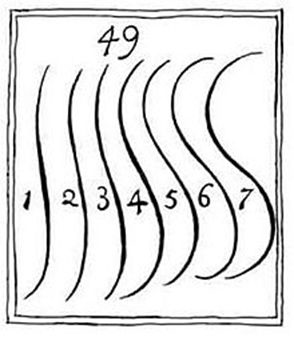
The line of Beauty is a theory in art or aesthetics used to describe an S-shaped curved line (a serpentine line) within an object.
The theory originates with William Hogarth and is an essential part of his theory of aesthetics as described in his Analysis of Beauty from 1753. According to his theory it is to be observed that straight lines vary only in length and therefore are left ornamental. Curved shaped curved lines signify liveliness and can vary in their degree of curvature as well as length.
This theory can be seen with the curved and recurved seam taken from Baldwin’s notes commencing from the bottom the seam first joins the back edge of the front body section and the front edge of the front hip gore. This seam passes along the rearwardly extending tongue of the front body section and joins that to the front of the back body section. It then passes of from the tongue and joins the back of the underarm section to the front of the back body section.
Initial Thoughts
When I first looked at the drawing of the corset I found it a little intimidating to envisage how the pieces would come together for the finished garments especially with the external bone casings providing the structure. I wanted to be clear on its construction and how it was intended to fit the body before I adapted the pattern to my own measurements
I therefore decided to do some further research into some of the history of the time. Moreover look at some of the corsets from this time and the assignor to Thomson, Langdon & CO.
History
The patent was assigned by Thomson – presumably Thomson, Langdon & Co. (American, founded 1865) was probably most known for his glove fitting style corsets. The illustrations below are actually of a later date so maybe this corset patent of 1887 as a fore runner to the later styles. The Foundations Revealed article by Marion McNealy provided a lovely timeline of the styles.

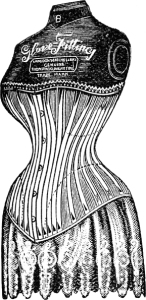
Corsets of 1887
I also used The Metropolitan Museum in New York online site for some visual sources of actual corsets from this period for inspiration on fit, colour and fabric. For anyone that is not familiar it’s well worth a look. Admittedly I did spend quite a while looking up corsets from this period but will just include a couple for the sake of the article.
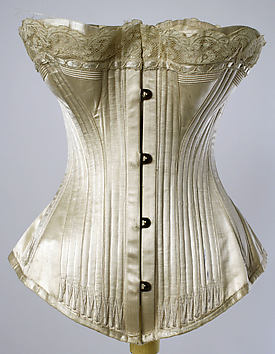
Ivory Silk Corset dated 1887 – Made of ivory silk the corset featured a front bust gusset. (Laura Loft has a useful article discussing gores and gussets). The article describes as a piece inserted between 2 panels and a gore being a panel inserted into a slit which was opened out during manufacture. The corset has a straight upper edge with a deep lace trim. The external bone casing were positioned close together at the centre front providing lots of support to the abdomen.

American corset dated between 1885-1887. Another corset featuring a gusset instead of a gore. I wondered whether this technique was used often. Gores would certainly be harder to insert pivoting the apex around the slit. The corsets of this time seemed to be cut quite low and straight over the bust perhaps keeping level with the overbust line. I also noticed that the corset lower edge sits high up on hip and featured a smooth dipping curve to the CF.
Planning Stages
My body frame is quite small so I was interested in whether the hip and bust gores would really work for me. Typically they provide capacity in these areas but being quite petite I wondered whether they would be too much and I would have to reduce them right down. Was there any point in making this corset for me? Or should I find someone of a more curvier figure. While I’m probably not the right figure for this style, never the less it would be interesting to see how this style of pattern would fit a small frame.
Things to consider – The sketches of the patents pieces would not be accurate scaled versions of the final corset. I would work with them loosely but would provide a good starting point for piecing together and seeing how the corset fitted together.
Observation – I would probably add some height into the bust gores as they came under the over bust line to make it more wearable for the modern day wearer me who wouldn’t be wearing it as an outer corset as opposed to undergarment
Measurements
Usually I work to a 2 inch reduction throughout my corset patterns for bust, waist and hips. However as the patent stated ‘The corset will conform to the curves of the figure without the necessity of pressing or forming it into shape’. I Decided on a 5cm/ 2″ reduction of the waist with less on the upper body and none on the lower body. I would still have some defintition of the waist without the corset being too constrictive.
Measurements
- Overbust: 76.5cm
- Underbust: 69cm
- Waist: 64cm
- Top hip: 79.5cm
- Full hip: 86 cm
- Over bust to underbust: 6.5cm
- Underbust to waist: 12cm
- Point of bust (POB to POB) 18cm
- Waist to top hip: 10cm
- Waist to full hip: 20cm
I then made a table to work out my corseted measurements:

Approach to the pattern
Baring in mind the patent was only an indication of the pattern pieces and not actually a pattern itself to adapt, I decided before working to any measurements to piece together the patent to get a 3rd visual idea of the pattern. This would help determine grain lines of the pieces as well.
As a commercial pattern cutter (my day job) I was fortunate enough for the purpose of this challenge to have access to a large scale plotter. Yay- this would save the time of lots of cutting and sticking.
I enlarged the patent to 600% a rough guess of the scale as a starting point. (on a side note the diagram was also printed out and proved most useful as a visual aid for how the panels were joined shown later on and for the bone placement.
I cut out and carefully pinned together the pieces of the patent in order to get a 3D impression of how the corset would shape to the body. The hip and bust gores gave a lot of shape and curve emphasis as noted by Baldwin in his patent. I found that the centre front and front panels gave the corset quite a curve over the abdomen demonstrate which could be seen on some of the images previously mentioned above. The curve was quite flattering and worn would smooth over the stomach area.
NOTE: I compared the 600% scaled version to my measurements and found they were way out. I repeated the exercise printing out the pieces to 500%. I intended on working with something slightly closer to my corseted measurements as a starting point.
Drafting the pattern
First, I used spot and cross paper (on the reverse), a method I use at work. I’m able to still see the faint markings from the reverse as a guide but don’t find it so distracting when working with small increments in the adjustment stage.
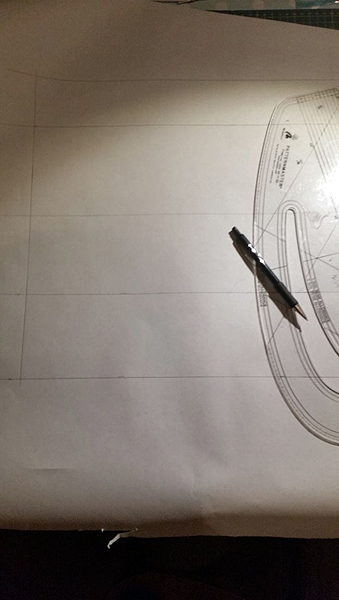
My first aim was to ensure the lines representing the overbust, underbust, waist, top hip and full hip were spaced according to my measurements. I lined up the waist on the scaled up patent pieces which I had gauged when it was placed on the mannequin on the main pieces now renamed CF, FRONT, BACK and CB and drew around.

I realised straight away that the position for the bust gore was in totally the wrong place in comparison to what my measurements said. This could be due to a couple of reasons. The main and probably most likely was the scale at which the pieces were enlarged by. Realistically to get a truer size the patent probably should have been enlarged somewhere between the 500 and 600 %. Also quickly comparing my measurement to that of my mannequin I realised that the length of my body between the underbust line and waist was greater. I decided that the next step would be extending the pattern at the waist so all the pieces lined up with the critical horizontal measurements axis.
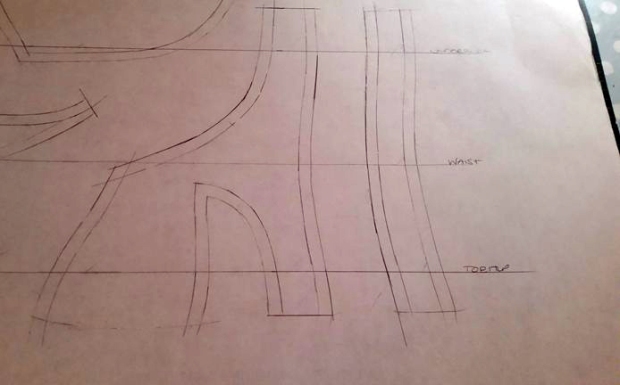

At this point I realised I most likely would make a couple of toiles. Working from a patent I wanted to get a feel for the corsets construction and it’s intended look. It was crucial that the pattern maintained the S bend curve through from the front and back. As I would be cutting right through the waist to extend the upper section of the pattern I would have to reshape the curved line.
At this point I decided I would ignore all the other measurements around the body and work first on the depth adding a total of 6.5 throughout the garment. I determined from piecing together the patent that the seam allowance included was roughly around 10mm. This was marked in to to avoid confusion. I carefully traced around the pattern ensuring that I marked in all the horizontal lines which would help repository the pieces. After some consideration I decided that I would add 5cm depth between the underbust and waist. Looking at where the hip gore started I decided also to drop from the waist to the top hip by 1.5cm
On the CF, FRONT, BACK, CB pieces I cut along the waist line


On a fresh sheet I marked in the waist position, I faintly marked lines 5cm above and 1.5cm below which would be my guide for repositioning the flat pieces. I drew around the pieces aligning them vertically. The centre front and centre back I simply filled in the gaps.


The front and back sections were more difficult and it took a couple of attempts to get the right shape curves. At this point I had to use the front hip gore to check my seam measurements were correct for the main curve that joined the front and back. This was probably the hardest part as the seam ran through so many pieces.


At this stage I also ensured that all the other seams aligned correctly before making my first toile.
Toile 1
Observations
- Hip gores start too low
- Too much bulge over abdomen
- Excess fabric over hip
- Excess fabric over bust
Toile amendments (work on the half)
- Raise waist line up by 1cm on all pieces ( which would lift up the hip gussets)
- Bust gore: pinch out 1cm

- Side bust gusset: panel pinch out 3 cm. Reshape upper edge. Reshape curve toward back to flatten it. Initially I was going to take the 3 cm from the centre of the piece but realised I would have too much of an angle at the centre point. Instead I took out 3 x 1cm equally spaced throughout the piece.
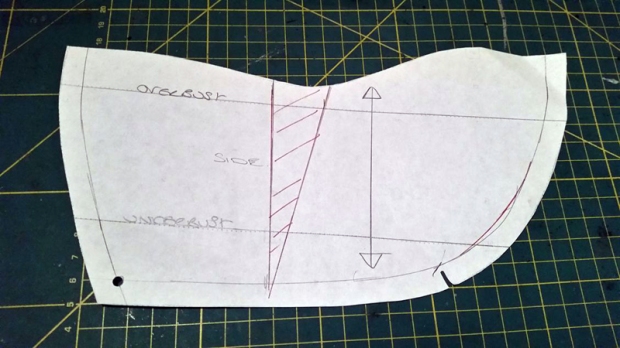
- Front hip gusset:. pinch out 1cm from centre lower edge to 0 at upper edge . Then reduce lower edge by 1cm reshaping main S bend curve.


- Front: Pivot pattern piece from waist down to move the seam over by 1cm this will eliminate some of the bulging over the abdomen. Pinch out 0.5m from main A bend curve at waist.

- Back: Pinch out 1.5cm from lower edge over hip.
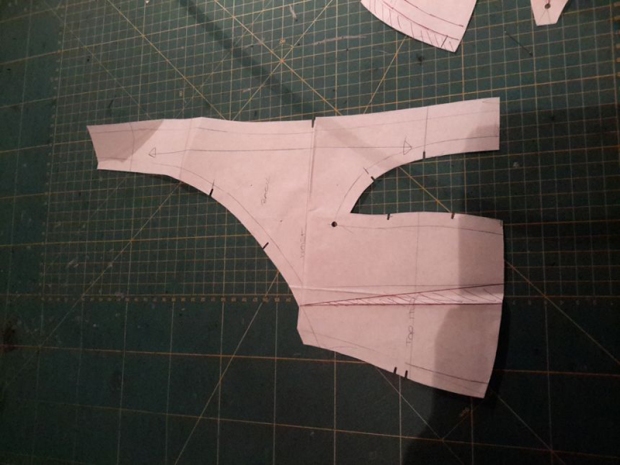
- Back hip gore: Pinch out 2.5cm from lower edge
Toile 2
For the second toile I considered construction methods and tested out how the final corset would be pieced together, this time also including the double stitching line and bone pockets.
For the boning I used a combination of spiral and flat steel bones. The flat steels were only used in the centre back panels to provide support either side of the eyelets. The Flexible steel was inserted into external Bone casings. This adds support but also allows for flexibility
Observation: This toile also allowed me to determine their placement. As I had taken out a fair amount of room over the hips I may not be able to use as many channels as were illustrated in the patent sketch.
Busk: I had determined that I would use a 14″ busk for the final corset. However for the sake of this toile I used something slightly shorter as my supplies were yet to arrive.











One comment